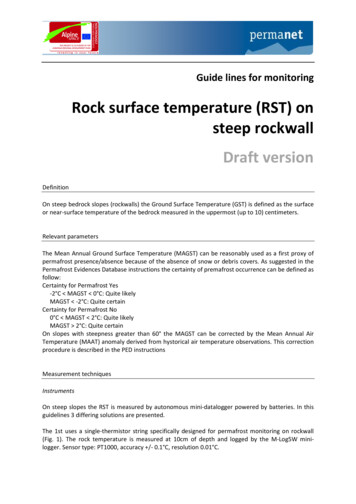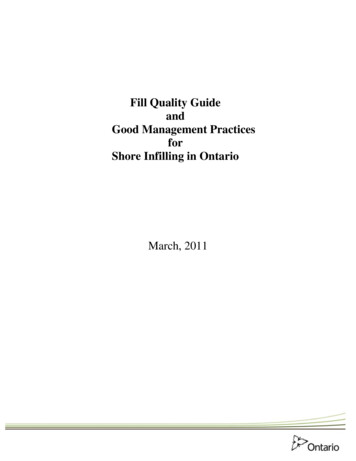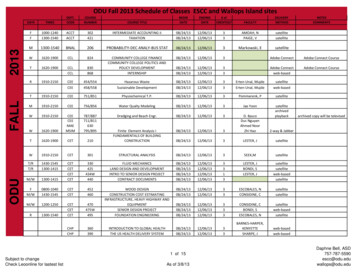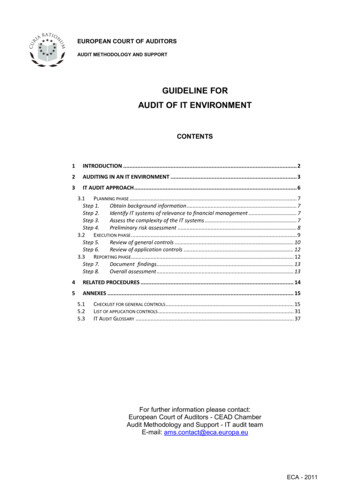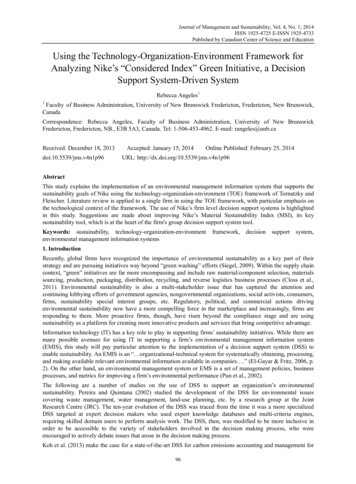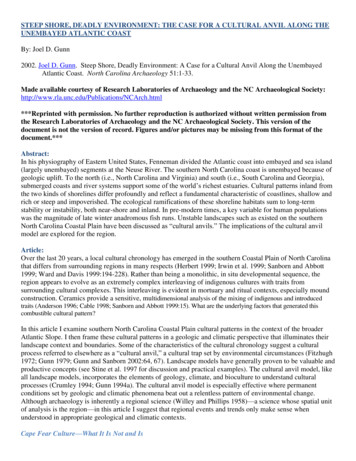
Transcription
STEEP SHORE, DEADLY ENVIRONMENT: THE CASE FOR A CULTURAL ANVIL ALONG THEUNEMBAYED ATLANTIC COASTBy: Joel D. Gunn2002. Joel D. Gunn. Steep Shore, Deadly Environment: A Case for a Cultural Anvil Along the UnembayedAtlantic Coast. North Carolina Archaeology 51:1-33.Made available courtesy of Research Laboratories of Archaeology and the NC Archaeological .html***Reprinted with permission. No further reproduction is authorized without written permission fromthe Research Laboratories of Archaeology and the NC Archaeological Society. This version of thedocument is not the version of record. Figures and/or pictures may be missing from this format of thedocument.***Abstract:In his physiography of Eastern United States, Fenneman divided the Atlantic coast into embayed and sea island(largely unembayed) segments at the Neuse River. The southern North Carolina coast is unembayed because ofgeologic uplift. To the north (i.e., North Carolina and Virginia) and south (i.e., South Carolina and Georgia),submerged coasts and river systems support some of the world’s richest estuaries. Cultural patterns inland fromthe two kinds of shorelines differ profoundly and reflect a fundamental characteristic of coastlines, shallow andrich or steep and impoverished. The ecological ramifications of these shoreline habitats sum to long-termstability or instability, both near-shore and inland. In pre-modern times, a key variable for human populationswas the magnitude of late winter anadromous fish runs. Unstable landscapes such as existed on the southernNorth Carolina Coastal Plain have been discussed as ―cultural anvils.‖ The implications of the cultural anvilmodel are explored for the region.Article:Over the last 20 years, a local cultural chronology has emerged in the southern Coastal Plain of North Carolinathat differs from surrounding regions in many respects (Herbert 1999; Irwin et al. 1999; Sanborn and Abbott1999; Ward and Davis 1999:194-228). Rather than being a monolithic, in situ developmental sequence, theregion appears to evolve as an extremely complex interleaving of indigenous cultures with traits fromsurrounding cultural complexes. This interleaving is evident in mortuary and ritual contexts, especially moundconstruction. Ceramics provide a sensitive, multidimensional analysis of the mixing of indigenous and introducedtraits (Anderson 1996; Cable 1998; Sanborn and Abbott 1999:15). What are the underlying factors that generated thiscombustible cultural pattern?In this article I examine southern North Carolina Coastal Plain cultural patterns in the context of the broaderAtlantic Slope. I then frame these cultural patterns in a geologic and climatic perspective that illuminates theirlandscape context and boundaries. Some of the characteristics of the cultural chronology suggest a culturalprocess referred to elsewhere as a ―cultural anvil,‖ a cultural trap set by environmental circumstances (Fitzhugh1972; Gunn 1979; Gunn and Sanborn 2002:64, 67). Landscape models have generally proven to be valuable andproductive concepts (see Stine et al. 1997 for discussion and practical examples). The cultural anvil model, likeall landscape models, incorporates the elements of geology, climate, and bioculture to understand culturalprocesses (Crumley 1994; Gunn 1994a). The cultural anvil model is especially effective where permanentconditions set by geologic and climatic phenomena beat out a relentless pattern of environmental change.Although archaeology is inherently a regional science (Willey and Phillips 1958)—a science whose spatial unitof analysis is the region—in this article I suggest that regional events and trends only make sense whenunderstood in appropriate geological and climatic contexts.Cape Fear Culture—What It Is Not and Is
The Coastal Plain within North Carolina (Figure 1) is divided by archaeologists at the Neuse River for a numberof reasons (Herbert and Mathis 1966; Phelps 1983; South 1960; Ward and Davis 1999:194–195). Not the leastof these reasons is that in historic times it was the boundary between the Iroquoian and Algonkian speakers tothe north and probable Siouan-speaking groups to the south (Abbott et al. 1995:25). South of the Neuse River isthe Cape Fear River, which parallels the border between North and South Carolina. The Cape Fear River basinis the focus of this study as it contains the characteristics that distinguish the southern Coastal Plain fromsurrounding regions. For reasons that will be discussed next, the northern South Carolina Coastal Plain sharesattributes with its North Carolina sister region (Cable 1998) and should be considered a part of this study.The prehistoric cultures of the Cape Fear River basin transition between the usual Archaic (8000–1000 B.C.)and Woodland (1000 B.C.– A.D. 1650) weapons systems and food preparation technologies: dart points toarrow points, fire cracked rock to ceramics. Some recent dating argues that ceramics may have developed asearly in the Cape Fear River valley as anywhere along the Atlantic Slope (Jones et al. 1997; Sanborn and Abbott1999:15). However, in the long term and broad areal perspectives, the regional cultural evidence remainsrelatively ephemeral across the millennia of prehistory. Although evidence is plentiful that people of the CoastalPlain knew of and had systematic exchanges of goods with Mississippian groups (A.D. 800–1600) to the westand south (Irwin et al. 1999:59; Ward and Davis 1999:210 ff), they never fully adopted the cultural regalia ofthe chiefdom- or state- based Mississippian
civilizations. This distinction is recognized in the local cultural chronology as a continuation of the Woodlandperiod until the seventeenth century. The period recognized in adjacent regions as Mississippian is termed LateWoodland (A.D. 800–1650) in the lower Cape Fear River valley.The disjunction between the cultures of the lower Cape Fear River and surrounding regions is nowhere moreapparent than in the distribution of accretional mounds, clay, rock, or sand structures designed initially formortuary purposes in the Woodland and later for ritual in the Mississippian (Willey 1966) (see Figure 1). Asnear as South Carolina (Frierson 2002), and in the Appalachian Mountains and foothills (Dunham 1994; Levy etal. 1990), such mounds were recapped generation after generation for 100s of years and grew to great size. Inthe Chesapeake Bay area, rock mounds were constructed, some to considerable heights with standing interments(Gardner 1993; Gunn 1994; Pigeon 1853). In great contrast to these intentional structures, on the southernCoastal Plain, occasional opportunistically appropriated natural sand mounds were used for multiple interments.A possible cluster of constructed low sand mounds has been identified near the Cape Fear River channel onRockfish Creek to the southwest of Fayetteville, North Carolina (Irwin et al. 1999:61; Ward and Davis1999:206–210). Artifacts recovered from these mound burials clearly indicate contact with Mississippiangroups, and perhaps origins from among them. They include 25 stone smoking pipes, some of which wereplatform pipes made in the style of the Ohio Valley Middle Woodland Hopewell tradition (Ward and Davis1999:207).A parallel line of evidence is historically recorded Indian trails. Recent research suggests that Indian trails insome cases may have origins as early as the Paleoindian period (M. Brooks, personal communication, 1998),and could have been elephant migration routes in the Pleistocene. A map of these trails as they were known inthe historic period (Myer 1971) shows major paths skirting the Coastal Plain along the edge of the Piedmont,and proceeding onto the Coastal Plain in South Carolina and Virginia, but seldom going into the Coastal Plainin North Carolina.The mound and path patterns seem to imply a rather donut-hole cultural enclave in the Coastal Plain. What arethe underlying causes of the cultural donut-hole? Although without imposing mounds and depopulated inhistorical times, the region was certainly culturally active in prehistory. As far as they can be traced, given a lessthan refined cultural chronology, on occasion migrations and/or diffusions of cultural traits appear to enter intothe southern Coastal Plain from north, south, or west, cross its landscape, but not penetrate beyond its oppositeboundary (Figure 2). In other words, they seem to be trapped or ―boxed in‖ by the southern Coastal Plain. Othercultural traits approach to or expand through the region. Ceramics varieties and some other traits provideexamples:
Into. There are several examples of traits penetrating into the region, but not spreading beyond it boundaries. Inthe Late Archaic (2000–1000 B.C.), Thom’s Creek sand-tempered ware with reed-punctate and plain surfacetreatments appeared in South Carolina and crossed into the region spreading to the Neuse River but not beyond(Herbert 1999:43). Soapstone- tempered ware (Marcey Creek, 1200–800 B.C.) spread from the Chesapeake Bayregion beyond the Neuse River (Herbert 1999:43). During the late Middle Woodland (around A.D. 600),Algonkian mortuary practices and physiology crept into the region from the north and halted half way across atthe New River, then retreated to the Neuse River by the historic period (Mathis 2000). (What conditions restraintraits from spreading beyond the regional boundary opposite that of entry?)To. Some traits ceased to advance at the boundary of the southern Coastal Plain. Croaker Landing clay and grogtempered ware reached only to the southern Coastal Plain northern boundary (Herbert 1999:43). The Algonkianmovements crossed into the southern Coastal Plain, but later retreated to the northern Coastal Plain beinglimited to it. (What conditions restrain traits from entering a region?)Through. Other traits extend through the southern Coastal Plain and into adjoining territories such as fibertempered ware, which originated in the south and is found as far north as the Chowan River (Herbert 1999:43).(Were key elements of the Middle Holocene climate so different that Stallings territory included a range beyondthe Neuse River? Or, was it merely that some Holocene climates extended the range of Spanish moss furthernorth along the coast? Was Stallings a water-oriented adaptation and thus not limited by the characteristics ofthe southern Coastal Plain?) Middle Woodland Deptford sand-tempered, check- stamped ceramics not onlycrossed the southern Coastal Plain, but also expanded in the form of Yadkin grit-tempered, check- stampedware into the westward adjacent Piedmont (Herbert 1999:44). (What were the contextual conditions thatpermitted these movements through the southern Coastal Plain into nearby regions?)
Out. Some varieties of ceramics appear to originate in the southern Coastal Plain and spread out from it.Hanover grog- tempered ware appears to begin in the region and later exit to South Carolina (Sanborn andAbbot 1999:15). Early Woodland Hamps Landing limestone tempered ware might be another such case as itappears in both North and South Carolina; dating remains ambiguous (Herbert 1999:43). (Under whatconditions did indigenous inventions spread out of the southern Coastal Plain?)The movement of cultural traits into the southern Coastal Plain has provoked an enduring debate. It has been thesubject of attention since South began his studies around the mouth of the Cape Fear (Ward and Davis1999:196). The cultural anvil hypothesis differs from that of South (1960) in that it supposes all boundaries ofthe southern Coastal Plain region pose filters and barriers to the flow of ideas and populations. The reason beingthat when the region is invaded, either by thought or deed, that movement presupposes a pre-adaptation to thethen-current conditions of the southern Coastal Plain in one of the three surrounding regions. The extent of themovement will be constrained at the opposite boundary by characteristics of the region unless that region hasassumed similar conditions. On occasions where new patterns run through the boundaries of the region,explanations other than environmental adaptation appear to be appropriate. For example, during the LateArchaic, fiber-tempered Stallings Island ceramics spread through the region as far north as the Chowan River(Herbert 1999:43; Ward and Davis 1999:199). Why was Thom’s Creek, the contemporary of Stallings Island,constrained by the northern boundary of the region while Stallings was not? In an equally interesting reverseperspective, Early Woodland Marcy Creek steatite- tempered ware (Ward and Davis 1999:199) and MiddleWoodland Mockley Creek (Ward and Davis 1999:203) found their southern limit at the Neuse River implying amal-adaptation to the then-current conditions that prevented its movement further south.The repeated occurrence of boundary-limited influxes of cultural phenomena into the southern Coastal Plainsuggests an enduring cultural process. In the following sections of this article I attempt to find possibleinfluencing factors that may underlie such a process. By ―process‖ I mean an identifiable cultural developmentthat reoccurs in a similar pattern multiple times. If it reoccurs twice, it is a possible process. If it reoccurs threetimes or more, it is a probable process. Support for a process emerges from the identification of a constellationof factors that arguably could account for the reoccurring features of the process. Since we view past culturesthrough their technologies, a new process will emerge with each new technological change such as the shiftfrom stone boiling to ceramic-vessel food preparation technologies.Cape Fear Arch—the Geological AnvilThe preeminent feature of the Atlantic coast that evidently separates the northern and southern Coastal Plain isthe contrast in coastlines. From the Neuse River north, the coastline winds it way through a fractal maze ofbays, islands, river mouth insets, and barrier islands. The length of the coastline from the Neuse to ChesapeakeBay traces five times the length of that to the south (Herbert and Mathis 1996; Phelps 1983; South 1960; Wardand Davis 1999:194–195). Early on, the contrasting features of the two zones of the coast impressed Fenneman(1938:38–46) enough for him to give separate names, ―embayed coast‖ to the north and ―sea island coast‖ to thesouth. Fenneman attributed this difference to the concave shape of the sea island segment of the coast. Theconcave coast focused tides accounting for higher tidal rises and more extreme water movements in and out ofriver mouths. This influx and outflux of sea water prevented the accretion of barrier islands and cut the coastinto island segments between river mouths.Culturally, the embayed-sea island distinction is significant because broad coastal estuaries such as those foundnorth of the Neuse River support the transference of large runs of migratory or anadromous fish between saltand fresh water. Such fish runs are a key survival issue among subsistence hunters and horticulturists since theyappear at a critical time of the year. During the late winter and early spring, food is most likely to be in shortsupply among hunters and gatherers and subsistence agriculturists (Gunn et al. 1998; Gunn and Stanyard 1999;Millis 1999). Thus, at the first level of analysis, the embayed coast could be expected to support a much moreplentiful key subsistence resource than the sea island segment of the coast. This pattern ramifies up the CoastalPlain to the Piedmont boundary or fall line, the highest point in the rivers where anadromous fish can reliably beexpected in the driest years (Gunn et al. 1998; V. Schneider, personal communication, 1998).
At the same time that Fenneman was describing the outline of the Atlantic slope, his geological colleagues werestudying the Cretaceous and Cenozoic geological strata of the Coastal Plain and developing information thatwould serve to explain the differences in coastal outlines, and ultimately refine the description. UpperCretaceous marine sediments were initially deposited around 100 million years ago against the crystallinePiedmont bedrock in deep formations (Sohl and Owens 1991). River deltas and near-shore currents did most ofthe work. Some time around the beginning of the Cenozoic (about 50 million years ago) the area of the southernCoastal Plain began uplift by geologic forces. Thus, while the Neuse River to the north and the Pee Dee River tothe south remained low and subject to marine transgression and deposition, the Cape Fear valley was upliftedand left high and somewhat dry, a feature referred to as the Cape Fear arch (Figure 3). The Cape Fear River andits tributary, Rockfish Creek southwest of Fayetteville, North Carolina, cut deep into the Cretaceous sediments.For this reason, most of the geological type sections of Cretaceous age deposits are in the deeply dissected innerCoastal Plain and Sand Hills around Fayetteville.
The consequences of this uplift are more than a little noticeable. The Neuse and Pee Dee rivers are soggy,meandering rivers that bury their history in ample sediment loads. Since the beginning of the uplift, the CapeFear River has been destroying its history as it cuts sideways to the southwest deep into a 100 million years ofaccumulation (Figure 4). Surrounding elevations are dry and occasionally have been near desert (Robinson1986; Sohl and Owens 1991). In the Middle Holocene (4500– 7500 B.P.), sand blew freely in the Cape Fearvalley, creating active sand dunes (Soller and Mills 1991:301–302). During the Illinoian glacial advance,blowouts appeared across the Cape Fear watershed on the Socastee formation, resulting in the highest densitybetween Maryland and Florida of Carolina Bays, or oval upland ponds (Bennett and Nelson 1991; Soller andMills 1991). These features are not visible in the Pee Dee and Neuse valleys because they were intermittentlyreworked by Cenozoic marine transgressions and not of sufficient elevation to support drought and the creationof aeolian features. The uplift also brings a solution to the unembayed character of the southern Coastal Plainshoreline. In the coastal zone, the steeper continental shelf created by the uplift imposes an attenuated breadth.In addition to the sea island process, the steep shore and narrow coastal zone further limits anadromous fishestuary habitat. The difference is so distinctive along the southern North Carolina coast that it will be referred tohere as the ―unembayed‖ portion of the sea island coast.We are privileged to a firsthand account from 1663 of conditions on the Cape Fear arch. Between September 24and December 4, 1663, the ships company of the Adventure explored the Cape Fear River basin traveling upseveral of its tributaries (Lawson 1967:72–79). It appears that they ascended just beyond present dayFayetteville in the main channel of the river. In the lower reaches of the Cape Fear valley they observed greatpines growing in barren ground, in other places large dried swamps they judged good for pasture. On theCoastal Plain they reported ―good lands‖ within two miles of the river but beyond that ―all Pine Land, but good
Pasture Ground‖ (Lawson 1967:75). Along the river channel above Fayetteville were oaks, pines, and a numberof other species of trees.Some judgments can be made about the moisture regime of the period from these observations. The pineparklands on the Coastal Plain suggest an active fire regime and insufficient spring moisture to supportdeciduous varieties of trees. However, the oak-pine forests in the Sand Hills-Fall Line zone indicate that theelevation of those features triggered enough precipitation in the spring on a regular basis to sustain temperatespecies. Apparently the hydrological regime was not moist enough near the coast to sustain the large seasonalswamps as they were dry and grassy. The Adventure exploration was during the later Little Ice Age (1650–1
the southern Coastal Plain region pose filters and barriers to the flow of ideas and populations. The reason being that when the region is invaded, either by thought or deed, that movement presupposes a pre-adaptation to the then-current conditions of the southern Coastal Plain i

